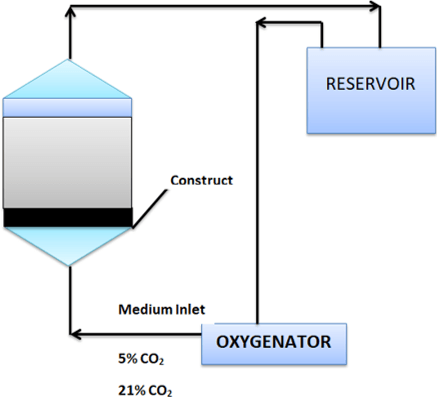This set of Tissue Engineering Multiple Choice Questions & Answers (MCQs) focuses on “Types of Bioreactors – 1”.
1. In _________ culture, fluid flow driven by a magnetic stir bar creates a well-mixed cell suspension.
a) spinner flask
b) agitator
c) magnetic stirrer
d) baffles
View Answer
Explanation: In spinner flask culture, a liquid stream driven by a magnetic stir bar makes a well-blended cell suspension for dynamic seeding and culture of the platforms that are fixed inside the cup on needles or wires.
2. Who invented the Rotating wall vessel bioreactor?
a) NASA
b) ISRO
c) IISC
d) DRDO
View Answer
Explanation: The Rotating wall vessel (RWV) was initially developed by NASA and right now has a few subordinates of the first structure that are executed today. There are three regular subordinates called the slow lateral turning vessel (STLV), the high aspect ratio vessel (HARV) and rotating wall perfused vessel (RWPV). The STLV is as of now accessible for business creation.
3. Commercial single-use bioreactors have been available since the end of the ______
a) 1990s
b) 1880s
c) 1900s
d) 1950s
View Answer
Explanation: A single-use bioreactor or disposable bioreactor is a bioreactor with a dispensable pack rather than a culture vessel. Ordinarily, this alludes to a bioreactor in which the fixing in contact with the phone culture will be plastic, and this coating is encased inside a progressively changeless structure (commonly, either a rocker or a cuboid or tube-shaped steel support). Business single-use bioreactors have been accessible since the finish of the 1990s.
4. The rotating wall structures provide reduced shear stress in Rotating wall vessel reactor.
a) TRUE
b) FALSE
View Answer
Explanation: The rotating wall structures provide reduced shear stress while maximizing mass transfer due to the microgravity environment generated by the rotation of the inner and outer cylinders.
5. A ________________ (PBR) is a bioreactor that utilizes a light source to cultivate phototrophic microorganisms.
a) Photo-bioreactor
b) Capacitor-reactor
c) Transducer-reactor
d) Electrochemical-reactor
View Answer
Explanation: A photo-bioreactor is a bioreactor that utilizes a light source for developing phototrophic microorganisms. These microorganisms use photosynthesis in order to create biomass from light and CO2 and incorporate green plants, macro & micro algae, cyanobacteria and purple colored microorganisms. Inside the fake condition of a photobioreactor, explicit conditions are deliberately controlled for particular species. Consequently, a photobioreactor permits a lot of higher development rates and virtue levels than anyplace in nature or environments like nature. Theoretically, phototropic biomass could be gotten from supplement rich wastewater and vent gas CO2 in a photobioreactor.
6. The perfusion system offers an alternative to the spinner flask technology as it combats the problems related to the static culture conditions.
a) TRUE
b) FALSE
View Answer
Explanation: The perfusion system offers an option in contrast to the spinner carafe innovation as it battles the issues identified with the static culture conditions. Commonly, static media does not give ideal cell development and along these lines discourages the cell’s capacity to move into the platform. These outcomes in a shell arrangement of cells on the outside of the framework rather than the ideal uniform dissemination. Perfusion frameworks always recharge the cells with crisp media with the utilization of chambers, segments, or cartridges that house the platform builds. The steady renewal of media upgrade supplement conveyance to the cells and help the cells to more readily separate.
7. What type of bioreactor is shown in the diagram?

a) Perfusion bioreactor
b) Photo-bioreactor
c) Spinning flask
d) Rotating wall vessel reactor
View Answer
Explanation: The perfusion system offers an option in contrast to the spinner carafe innovation as it battles the issues identified with the static culture conditions. Commonly, static media does not give ideal cell development and along these lines discourages the cell’s capacity to move into the platform. These outcomes in a shell arrangement of cells on the outside of the framework rather than the ideal uniform dissemination. Perfusion frameworks always recharge the cells with crisp media with the utilization of chambers, segments, or cartridges that house the platform builds. The steady renewal of media upgrade supplement conveyance to the cells and help the cells to more readily separate.
Sanfoundry Global Education & Learning Series – Tissue Engineering.
To practice all areas of Tissue Engineering, here is complete set of 1000+ Multiple Choice Questions and Answers.
If you find a mistake in question / option / answer, kindly take a screenshot and email to [email protected]
- Apply for Biotechnology Internship
- Practice Biotechnology MCQs
- Check Tissue Engineering Books
- Check Biotechnology Books
